Employability Skills Report: Reflective Models and Skills Analysis
VerifiedAdded on 2023/01/03
|9
|2587
|70
Report
AI Summary
This report delves into the critical realm of employability skills, essential for academic and professional success. It begins by introducing the significance of these skills, emphasizing their role in securing and maintaining employment opportunities, and highlighting the importance of soft skills such as communication and teamwork. The report then explores two prominent models: Kolb's reflective cycle, which emphasizes experiential learning through concrete experience, reflective observation, abstract conceptualization, and active experimentation, and Gibbs' reflective cycle, which promotes learning from experiences through description, feeling, evaluation, analysis, conclusion, and action planning. The report further analyzes the application of these models in developing key employability skills, including foundational, interpersonal, communication, teamwork, and career development skills. The conclusion reinforces the importance of these skills for enhancing career prospects and acknowledges the contribution of Desklib in providing resources for students.
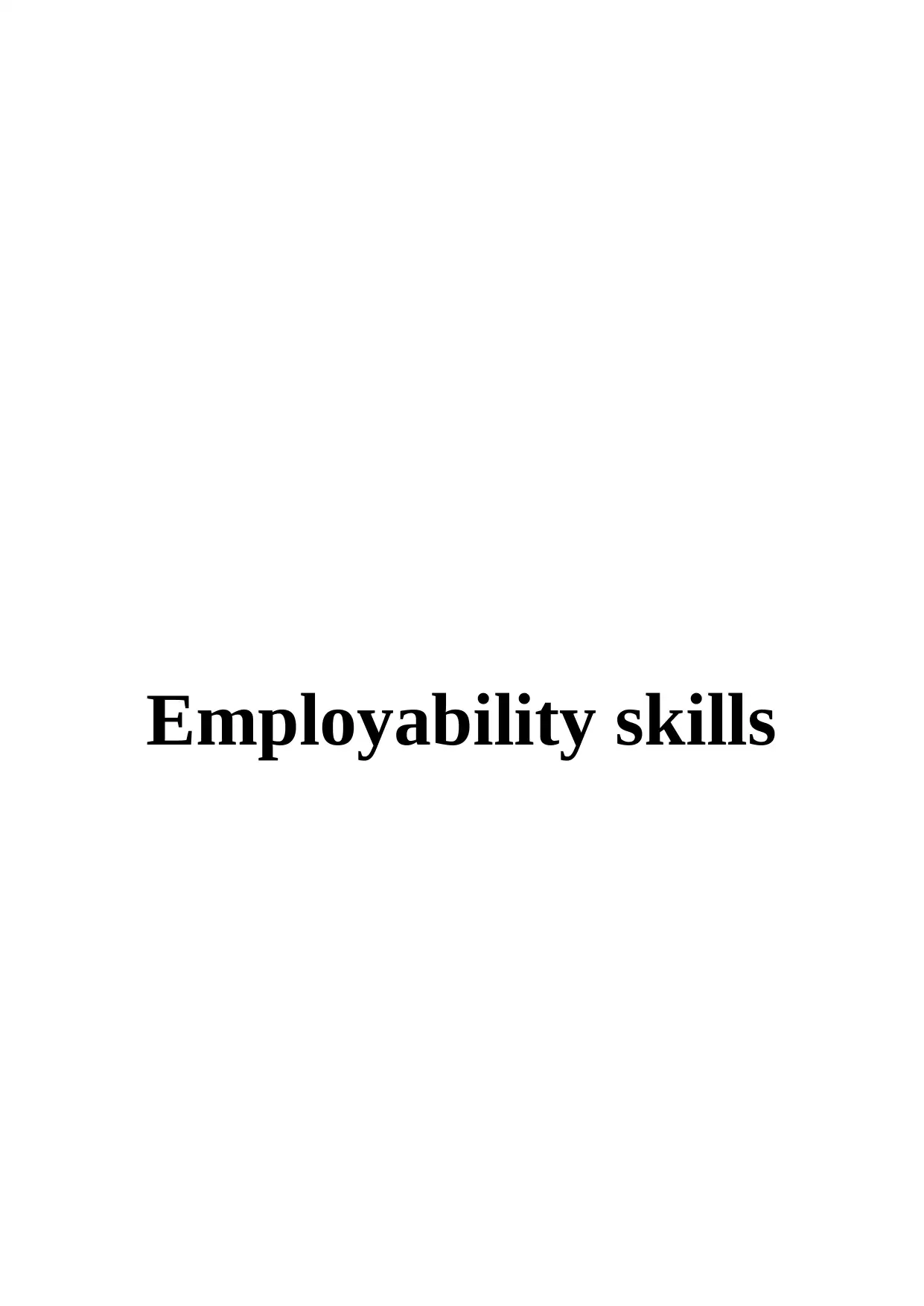
Employability skills
Paraphrase This Document
Need a fresh take? Get an instant paraphrase of this document with our AI Paraphraser
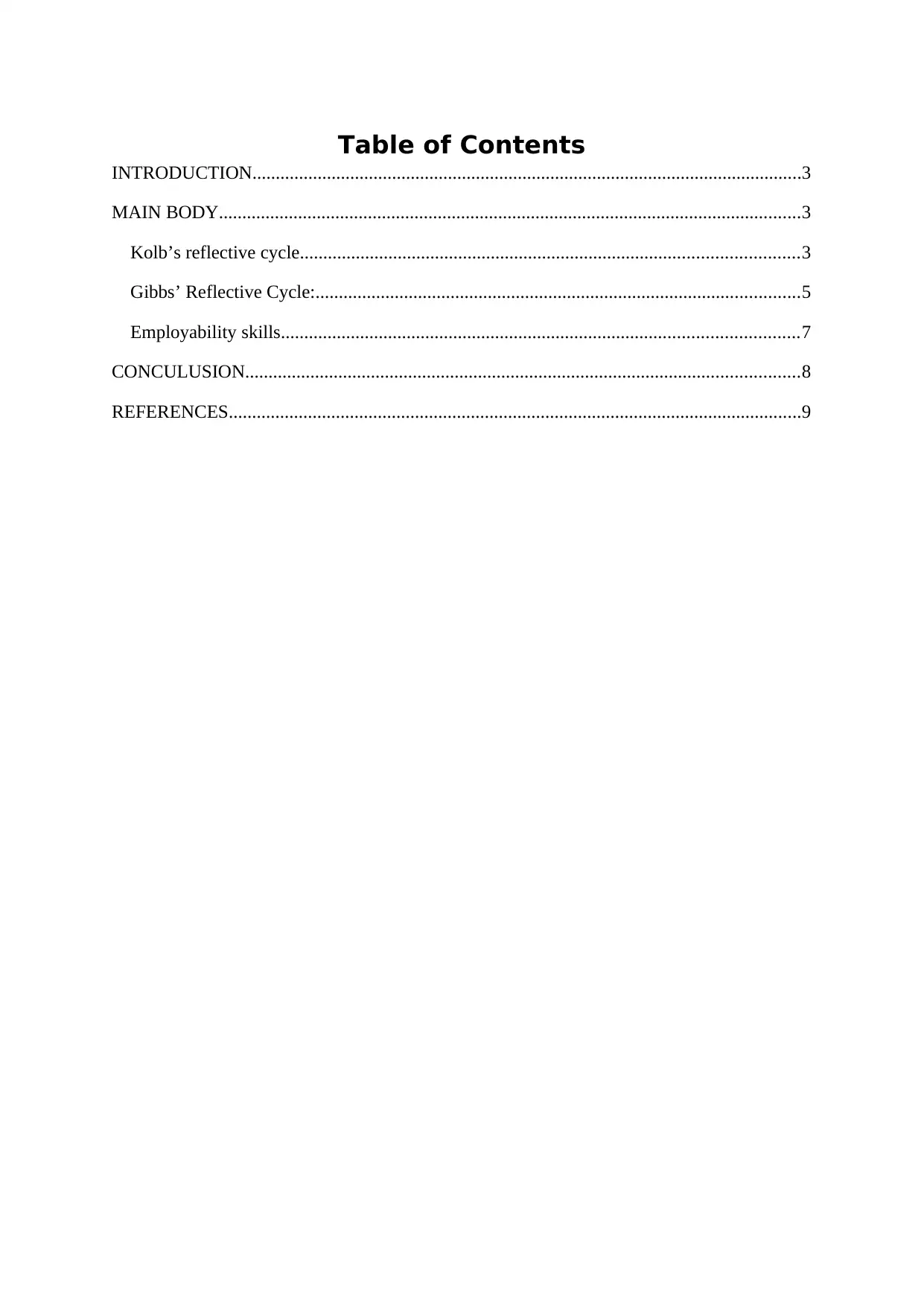
Table of Contents
INTRODUCTION......................................................................................................................3
MAIN BODY.............................................................................................................................3
Kolb’s reflective cycle...........................................................................................................3
Gibbs’ Reflective Cycle:........................................................................................................5
Employability skills...............................................................................................................7
CONCULUSION.......................................................................................................................8
REFERENCES...........................................................................................................................9
INTRODUCTION......................................................................................................................3
MAIN BODY.............................................................................................................................3
Kolb’s reflective cycle...........................................................................................................3
Gibbs’ Reflective Cycle:........................................................................................................5
Employability skills...............................................................................................................7
CONCULUSION.......................................................................................................................8
REFERENCES...........................................................................................................................9
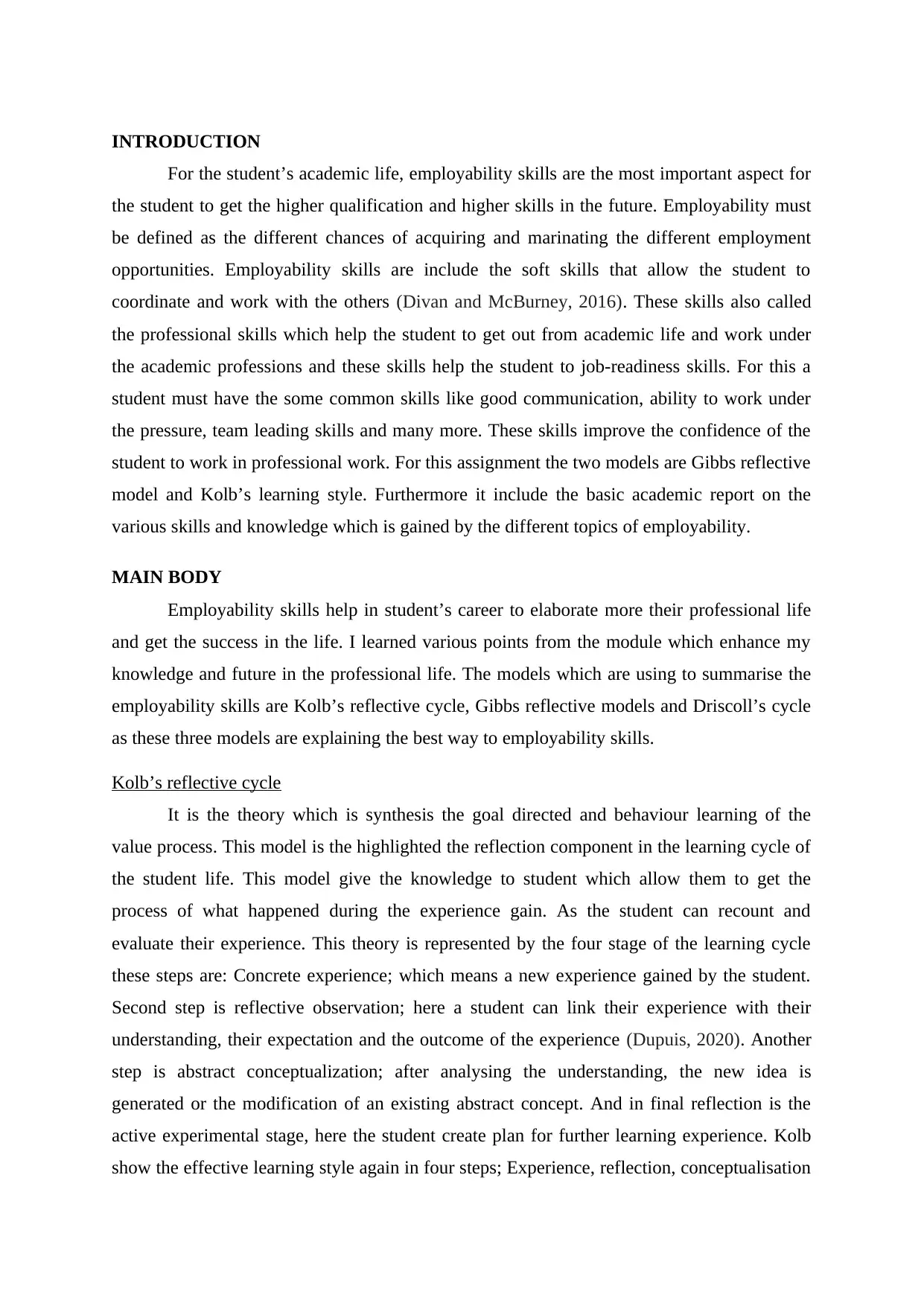
INTRODUCTION
For the student’s academic life, employability skills are the most important aspect for
the student to get the higher qualification and higher skills in the future. Employability must
be defined as the different chances of acquiring and marinating the different employment
opportunities. Employability skills are include the soft skills that allow the student to
coordinate and work with the others (Divan and McBurney, 2016). These skills also called
the professional skills which help the student to get out from academic life and work under
the academic professions and these skills help the student to job-readiness skills. For this a
student must have the some common skills like good communication, ability to work under
the pressure, team leading skills and many more. These skills improve the confidence of the
student to work in professional work. For this assignment the two models are Gibbs reflective
model and Kolb’s learning style. Furthermore it include the basic academic report on the
various skills and knowledge which is gained by the different topics of employability.
MAIN BODY
Employability skills help in student’s career to elaborate more their professional life
and get the success in the life. I learned various points from the module which enhance my
knowledge and future in the professional life. The models which are using to summarise the
employability skills are Kolb’s reflective cycle, Gibbs reflective models and Driscoll’s cycle
as these three models are explaining the best way to employability skills.
Kolb’s reflective cycle
It is the theory which is synthesis the goal directed and behaviour learning of the
value process. This model is the highlighted the reflection component in the learning cycle of
the student life. This model give the knowledge to student which allow them to get the
process of what happened during the experience gain. As the student can recount and
evaluate their experience. This theory is represented by the four stage of the learning cycle
these steps are: Concrete experience; which means a new experience gained by the student.
Second step is reflective observation; here a student can link their experience with their
understanding, their expectation and the outcome of the experience (Dupuis, 2020). Another
step is abstract conceptualization; after analysing the understanding, the new idea is
generated or the modification of an existing abstract concept. And in final reflection is the
active experimental stage, here the student create plan for further learning experience. Kolb
show the effective learning style again in four steps; Experience, reflection, conceptualisation
For the student’s academic life, employability skills are the most important aspect for
the student to get the higher qualification and higher skills in the future. Employability must
be defined as the different chances of acquiring and marinating the different employment
opportunities. Employability skills are include the soft skills that allow the student to
coordinate and work with the others (Divan and McBurney, 2016). These skills also called
the professional skills which help the student to get out from academic life and work under
the academic professions and these skills help the student to job-readiness skills. For this a
student must have the some common skills like good communication, ability to work under
the pressure, team leading skills and many more. These skills improve the confidence of the
student to work in professional work. For this assignment the two models are Gibbs reflective
model and Kolb’s learning style. Furthermore it include the basic academic report on the
various skills and knowledge which is gained by the different topics of employability.
MAIN BODY
Employability skills help in student’s career to elaborate more their professional life
and get the success in the life. I learned various points from the module which enhance my
knowledge and future in the professional life. The models which are using to summarise the
employability skills are Kolb’s reflective cycle, Gibbs reflective models and Driscoll’s cycle
as these three models are explaining the best way to employability skills.
Kolb’s reflective cycle
It is the theory which is synthesis the goal directed and behaviour learning of the
value process. This model is the highlighted the reflection component in the learning cycle of
the student life. This model give the knowledge to student which allow them to get the
process of what happened during the experience gain. As the student can recount and
evaluate their experience. This theory is represented by the four stage of the learning cycle
these steps are: Concrete experience; which means a new experience gained by the student.
Second step is reflective observation; here a student can link their experience with their
understanding, their expectation and the outcome of the experience (Dupuis, 2020). Another
step is abstract conceptualization; after analysing the understanding, the new idea is
generated or the modification of an existing abstract concept. And in final reflection is the
active experimental stage, here the student create plan for further learning experience. Kolb
show the effective learning style again in four steps; Experience, reflection, conceptualisation
⊘ This is a preview!⊘
Do you want full access?
Subscribe today to unlock all pages.

Trusted by 1+ million students worldwide
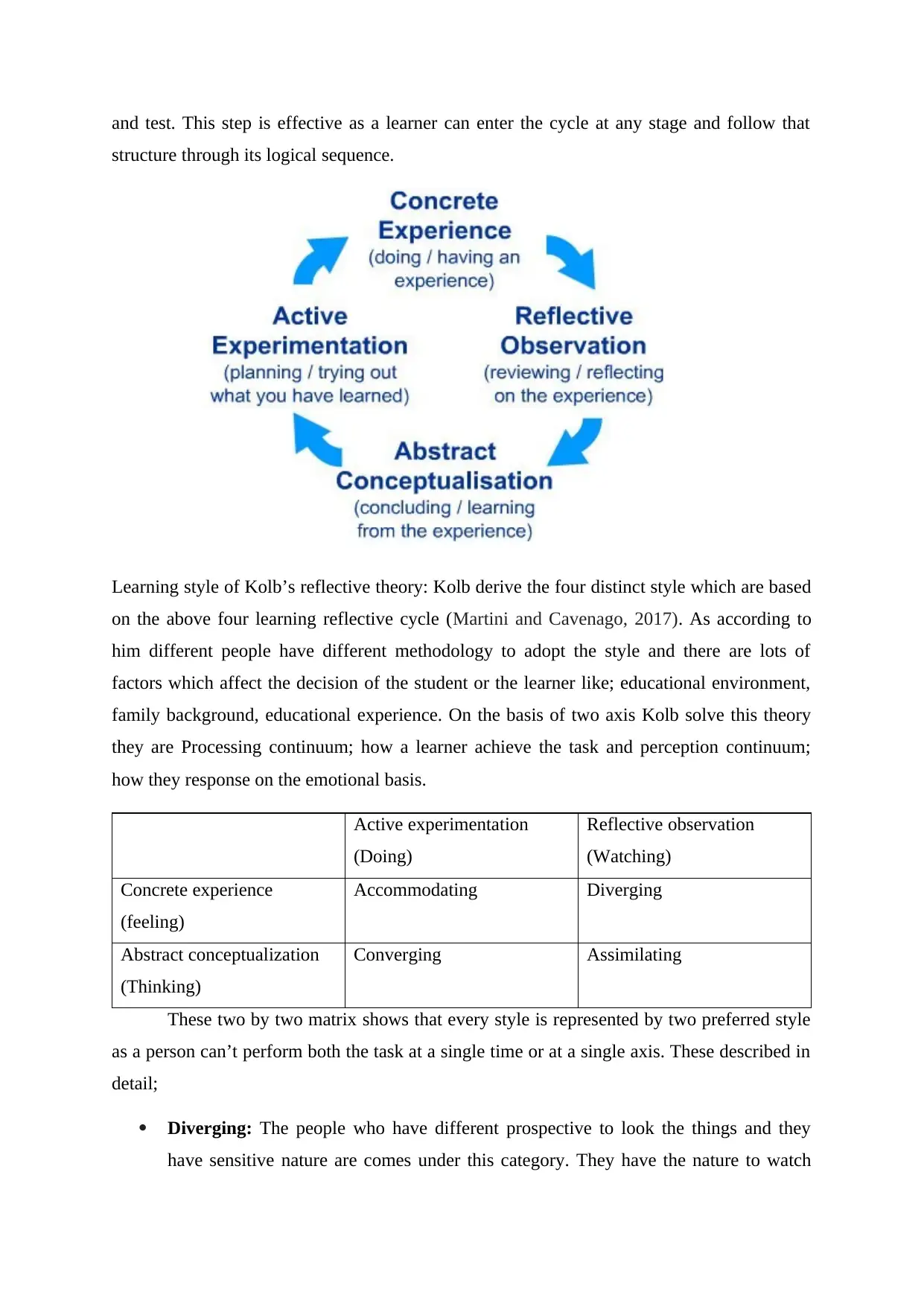
and test. This step is effective as a learner can enter the cycle at any stage and follow that
structure through its logical sequence.
Learning style of Kolb’s reflective theory: Kolb derive the four distinct style which are based
on the above four learning reflective cycle (Martini and Cavenago, 2017). As according to
him different people have different methodology to adopt the style and there are lots of
factors which affect the decision of the student or the learner like; educational environment,
family background, educational experience. On the basis of two axis Kolb solve this theory
they are Processing continuum; how a learner achieve the task and perception continuum;
how they response on the emotional basis.
Active experimentation
(Doing)
Reflective observation
(Watching)
Concrete experience
(feeling)
Accommodating Diverging
Abstract conceptualization
(Thinking)
Converging Assimilating
These two by two matrix shows that every style is represented by two preferred style
as a person can’t perform both the task at a single time or at a single axis. These described in
detail;
Diverging: The people who have different prospective to look the things and they
have sensitive nature are comes under this category. They have the nature to watch
structure through its logical sequence.
Learning style of Kolb’s reflective theory: Kolb derive the four distinct style which are based
on the above four learning reflective cycle (Martini and Cavenago, 2017). As according to
him different people have different methodology to adopt the style and there are lots of
factors which affect the decision of the student or the learner like; educational environment,
family background, educational experience. On the basis of two axis Kolb solve this theory
they are Processing continuum; how a learner achieve the task and perception continuum;
how they response on the emotional basis.
Active experimentation
(Doing)
Reflective observation
(Watching)
Concrete experience
(feeling)
Accommodating Diverging
Abstract conceptualization
(Thinking)
Converging Assimilating
These two by two matrix shows that every style is represented by two preferred style
as a person can’t perform both the task at a single time or at a single axis. These described in
detail;
Diverging: The people who have different prospective to look the things and they
have sensitive nature are comes under this category. They have the nature to watch
Paraphrase This Document
Need a fresh take? Get an instant paraphrase of this document with our AI Paraphraser
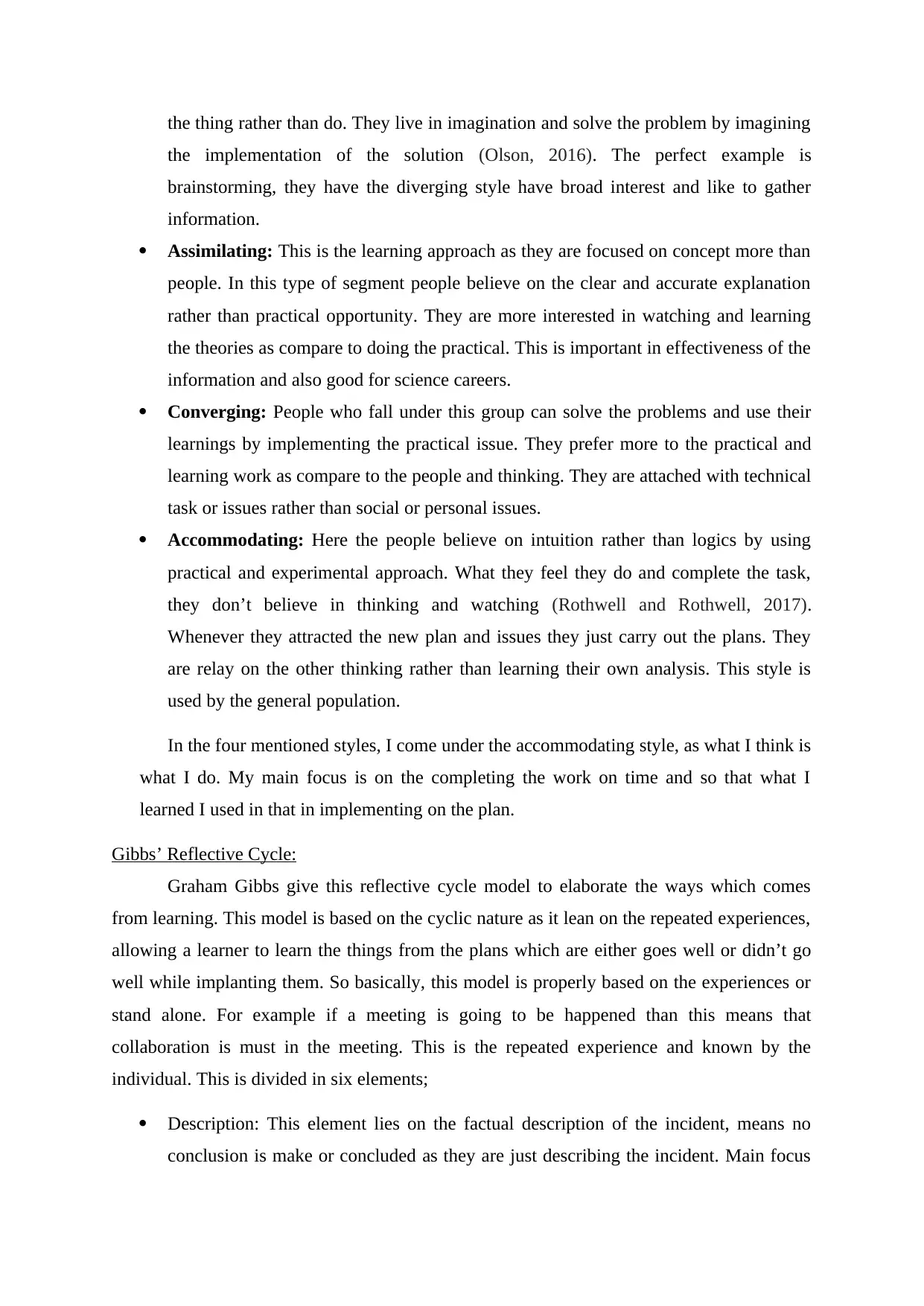
the thing rather than do. They live in imagination and solve the problem by imagining
the implementation of the solution (Olson, 2016). The perfect example is
brainstorming, they have the diverging style have broad interest and like to gather
information.
Assimilating: This is the learning approach as they are focused on concept more than
people. In this type of segment people believe on the clear and accurate explanation
rather than practical opportunity. They are more interested in watching and learning
the theories as compare to doing the practical. This is important in effectiveness of the
information and also good for science careers.
Converging: People who fall under this group can solve the problems and use their
learnings by implementing the practical issue. They prefer more to the practical and
learning work as compare to the people and thinking. They are attached with technical
task or issues rather than social or personal issues.
Accommodating: Here the people believe on intuition rather than logics by using
practical and experimental approach. What they feel they do and complete the task,
they don’t believe in thinking and watching (Rothwell and Rothwell, 2017).
Whenever they attracted the new plan and issues they just carry out the plans. They
are relay on the other thinking rather than learning their own analysis. This style is
used by the general population.
In the four mentioned styles, I come under the accommodating style, as what I think is
what I do. My main focus is on the completing the work on time and so that what I
learned I used in that in implementing on the plan.
Gibbs’ Reflective Cycle:
Graham Gibbs give this reflective cycle model to elaborate the ways which comes
from learning. This model is based on the cyclic nature as it lean on the repeated experiences,
allowing a learner to learn the things from the plans which are either goes well or didn’t go
well while implanting them. So basically, this model is properly based on the experiences or
stand alone. For example if a meeting is going to be happened than this means that
collaboration is must in the meeting. This is the repeated experience and known by the
individual. This is divided in six elements;
Description: This element lies on the factual description of the incident, means no
conclusion is make or concluded as they are just describing the incident. Main focus
the implementation of the solution (Olson, 2016). The perfect example is
brainstorming, they have the diverging style have broad interest and like to gather
information.
Assimilating: This is the learning approach as they are focused on concept more than
people. In this type of segment people believe on the clear and accurate explanation
rather than practical opportunity. They are more interested in watching and learning
the theories as compare to doing the practical. This is important in effectiveness of the
information and also good for science careers.
Converging: People who fall under this group can solve the problems and use their
learnings by implementing the practical issue. They prefer more to the practical and
learning work as compare to the people and thinking. They are attached with technical
task or issues rather than social or personal issues.
Accommodating: Here the people believe on intuition rather than logics by using
practical and experimental approach. What they feel they do and complete the task,
they don’t believe in thinking and watching (Rothwell and Rothwell, 2017).
Whenever they attracted the new plan and issues they just carry out the plans. They
are relay on the other thinking rather than learning their own analysis. This style is
used by the general population.
In the four mentioned styles, I come under the accommodating style, as what I think is
what I do. My main focus is on the completing the work on time and so that what I
learned I used in that in implementing on the plan.
Gibbs’ Reflective Cycle:
Graham Gibbs give this reflective cycle model to elaborate the ways which comes
from learning. This model is based on the cyclic nature as it lean on the repeated experiences,
allowing a learner to learn the things from the plans which are either goes well or didn’t go
well while implanting them. So basically, this model is properly based on the experiences or
stand alone. For example if a meeting is going to be happened than this means that
collaboration is must in the meeting. This is the repeated experience and known by the
individual. This is divided in six elements;
Description: This element lies on the factual description of the incident, means no
conclusion is make or concluded as they are just describing the incident. Main focus
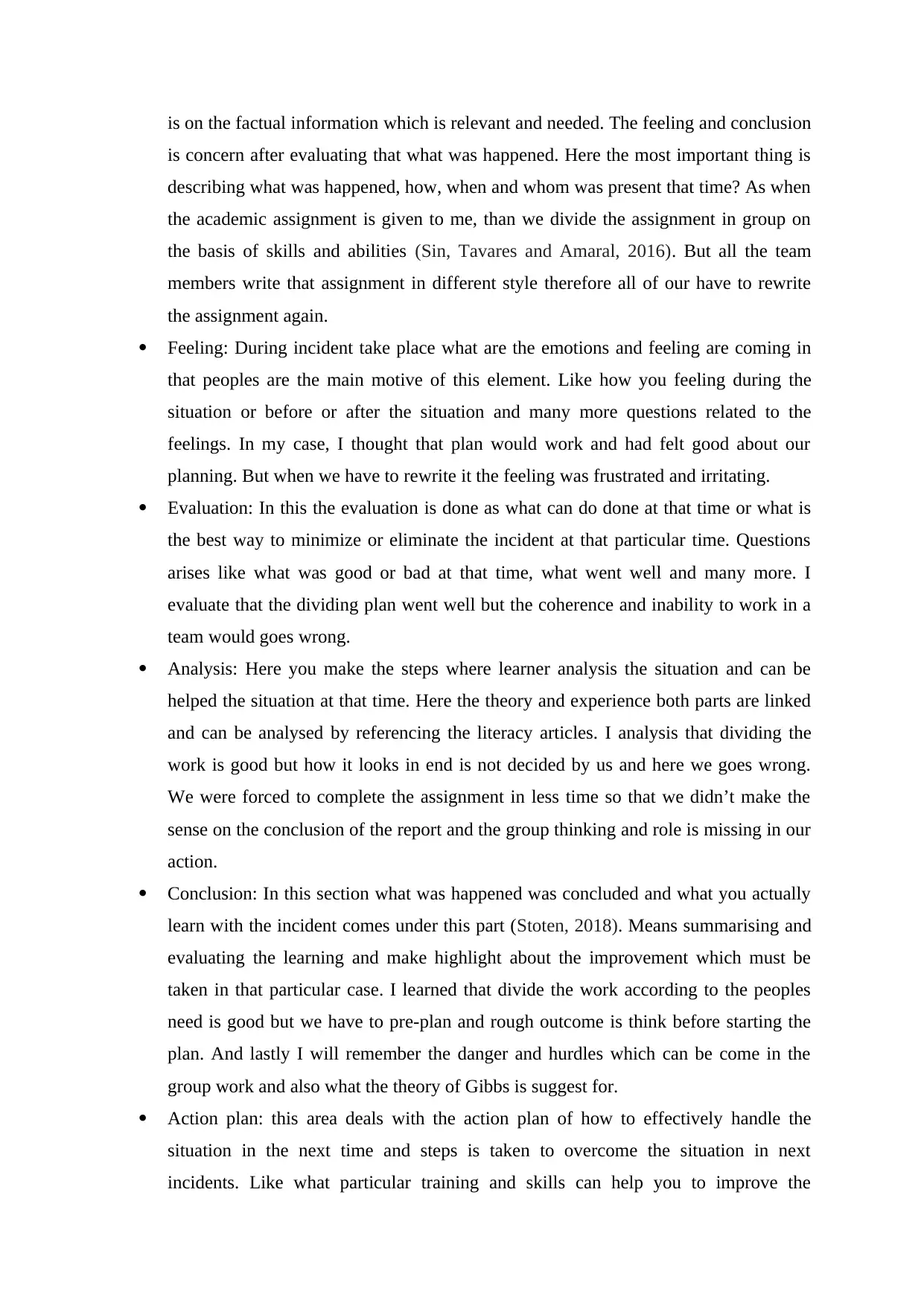
is on the factual information which is relevant and needed. The feeling and conclusion
is concern after evaluating that what was happened. Here the most important thing is
describing what was happened, how, when and whom was present that time? As when
the academic assignment is given to me, than we divide the assignment in group on
the basis of skills and abilities (Sin, Tavares and Amaral, 2016). But all the team
members write that assignment in different style therefore all of our have to rewrite
the assignment again.
Feeling: During incident take place what are the emotions and feeling are coming in
that peoples are the main motive of this element. Like how you feeling during the
situation or before or after the situation and many more questions related to the
feelings. In my case, I thought that plan would work and had felt good about our
planning. But when we have to rewrite it the feeling was frustrated and irritating.
Evaluation: In this the evaluation is done as what can do done at that time or what is
the best way to minimize or eliminate the incident at that particular time. Questions
arises like what was good or bad at that time, what went well and many more. I
evaluate that the dividing plan went well but the coherence and inability to work in a
team would goes wrong.
Analysis: Here you make the steps where learner analysis the situation and can be
helped the situation at that time. Here the theory and experience both parts are linked
and can be analysed by referencing the literacy articles. I analysis that dividing the
work is good but how it looks in end is not decided by us and here we goes wrong.
We were forced to complete the assignment in less time so that we didn’t make the
sense on the conclusion of the report and the group thinking and role is missing in our
action.
Conclusion: In this section what was happened was concluded and what you actually
learn with the incident comes under this part (Stoten, 2018). Means summarising and
evaluating the learning and make highlight about the improvement which must be
taken in that particular case. I learned that divide the work according to the peoples
need is good but we have to pre-plan and rough outcome is think before starting the
plan. And lastly I will remember the danger and hurdles which can be come in the
group work and also what the theory of Gibbs is suggest for.
Action plan: this area deals with the action plan of how to effectively handle the
situation in the next time and steps is taken to overcome the situation in next
incidents. Like what particular training and skills can help you to improve the
is concern after evaluating that what was happened. Here the most important thing is
describing what was happened, how, when and whom was present that time? As when
the academic assignment is given to me, than we divide the assignment in group on
the basis of skills and abilities (Sin, Tavares and Amaral, 2016). But all the team
members write that assignment in different style therefore all of our have to rewrite
the assignment again.
Feeling: During incident take place what are the emotions and feeling are coming in
that peoples are the main motive of this element. Like how you feeling during the
situation or before or after the situation and many more questions related to the
feelings. In my case, I thought that plan would work and had felt good about our
planning. But when we have to rewrite it the feeling was frustrated and irritating.
Evaluation: In this the evaluation is done as what can do done at that time or what is
the best way to minimize or eliminate the incident at that particular time. Questions
arises like what was good or bad at that time, what went well and many more. I
evaluate that the dividing plan went well but the coherence and inability to work in a
team would goes wrong.
Analysis: Here you make the steps where learner analysis the situation and can be
helped the situation at that time. Here the theory and experience both parts are linked
and can be analysed by referencing the literacy articles. I analysis that dividing the
work is good but how it looks in end is not decided by us and here we goes wrong.
We were forced to complete the assignment in less time so that we didn’t make the
sense on the conclusion of the report and the group thinking and role is missing in our
action.
Conclusion: In this section what was happened was concluded and what you actually
learn with the incident comes under this part (Stoten, 2018). Means summarising and
evaluating the learning and make highlight about the improvement which must be
taken in that particular case. I learned that divide the work according to the peoples
need is good but we have to pre-plan and rough outcome is think before starting the
plan. And lastly I will remember the danger and hurdles which can be come in the
group work and also what the theory of Gibbs is suggest for.
Action plan: this area deals with the action plan of how to effectively handle the
situation in the next time and steps is taken to overcome the situation in next
incidents. Like what particular training and skills can help you to improve the
⊘ This is a preview!⊘
Do you want full access?
Subscribe today to unlock all pages.

Trusted by 1+ million students worldwide
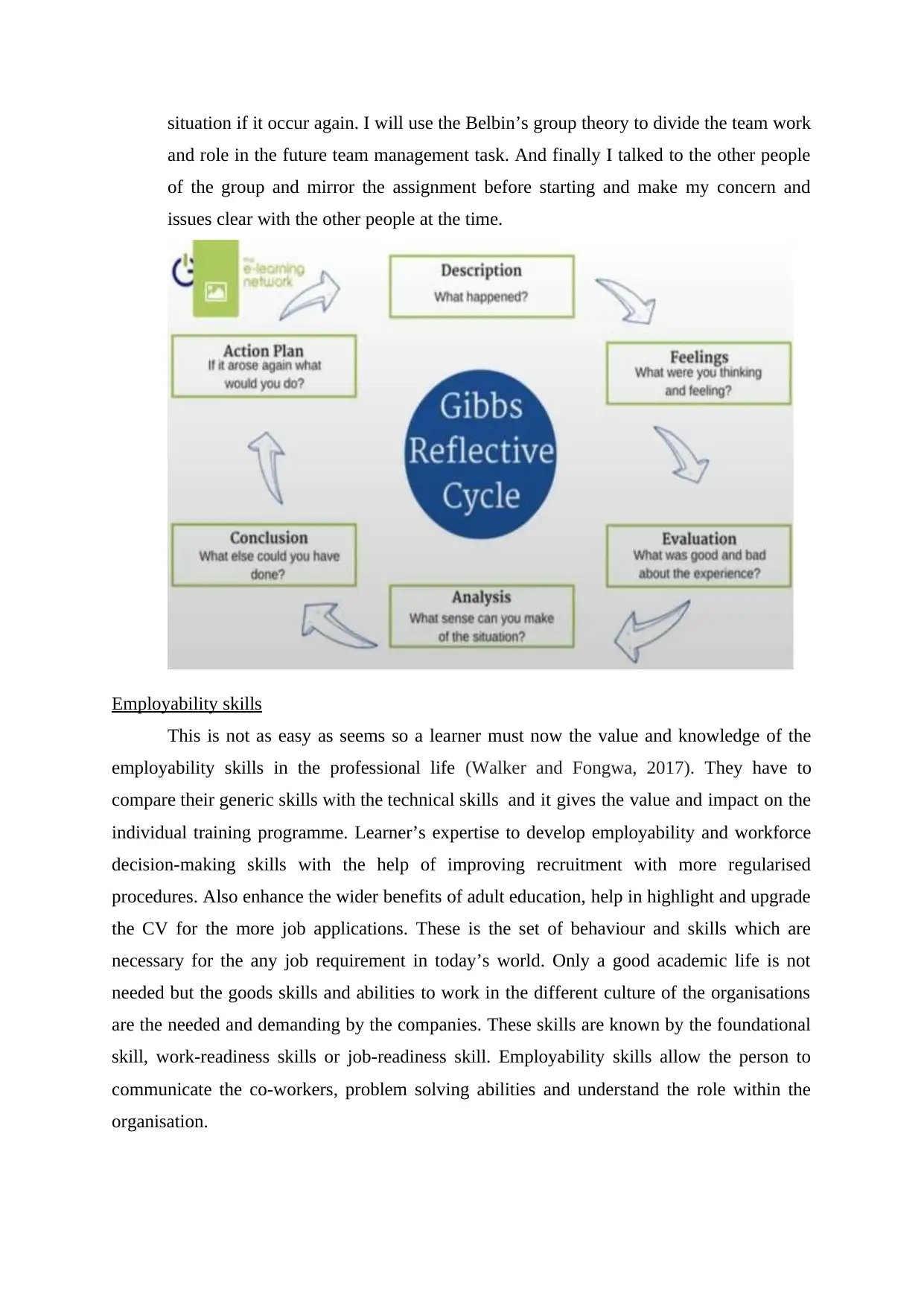
situation if it occur again. I will use the Belbin’s group theory to divide the team work
and role in the future team management task. And finally I talked to the other people
of the group and mirror the assignment before starting and make my concern and
issues clear with the other people at the time.
Employability skills
This is not as easy as seems so a learner must now the value and knowledge of the
employability skills in the professional life (Walker and Fongwa, 2017). They have to
compare their generic skills with the technical skills and it gives the value and impact on the
individual training programme. Learner’s expertise to develop employability and workforce
decision-making skills with the help of improving recruitment with more regularised
procedures. Also enhance the wider benefits of adult education, help in highlight and upgrade
the CV for the more job applications. These is the set of behaviour and skills which are
necessary for the any job requirement in today’s world. Only a good academic life is not
needed but the goods skills and abilities to work in the different culture of the organisations
are the needed and demanding by the companies. These skills are known by the foundational
skill, work-readiness skills or job-readiness skill. Employability skills allow the person to
communicate the co-workers, problem solving abilities and understand the role within the
organisation.
and role in the future team management task. And finally I talked to the other people
of the group and mirror the assignment before starting and make my concern and
issues clear with the other people at the time.
Employability skills
This is not as easy as seems so a learner must now the value and knowledge of the
employability skills in the professional life (Walker and Fongwa, 2017). They have to
compare their generic skills with the technical skills and it gives the value and impact on the
individual training programme. Learner’s expertise to develop employability and workforce
decision-making skills with the help of improving recruitment with more regularised
procedures. Also enhance the wider benefits of adult education, help in highlight and upgrade
the CV for the more job applications. These is the set of behaviour and skills which are
necessary for the any job requirement in today’s world. Only a good academic life is not
needed but the goods skills and abilities to work in the different culture of the organisations
are the needed and demanding by the companies. These skills are known by the foundational
skill, work-readiness skills or job-readiness skill. Employability skills allow the person to
communicate the co-workers, problem solving abilities and understand the role within the
organisation.
Paraphrase This Document
Need a fresh take? Get an instant paraphrase of this document with our AI Paraphraser

Foundational skills: In this the skills which are organised be organised in the nature,
ready to work on time or early if possible, having a positive attitude toward work
(Watkins and Smith, 2018). Furthermore seek out the information to improve skills
and be flexible and adoptable.
Interpersonal skills: This included the skills, be friendly and polite with the other
peer members of the company. Always analysis the feedback from the top
management and make corrective steps in order to arrange minimize the constructive
criticism.
Communication skills: In this I will evaluate the read and understanding of the
written materials, always follow the directions provided by the top management of the
company. And always try to express my idea and while speaking or writing.
Teamwork: I always try to become comfortable working with people of diverse
backgrounds, whenever the team is needed be sensitive to other People’s needs. I
always take my responsibilities for my own work. And always contribute to team
goals and help them to achieve them.
Career development: For my career development the skills which are help in my
career growth in professional development life. Always work on the work
communities which increase my social networks in the community of the professional
work.
These skills help my career growth and employability skills to enhance the career
growth in the professional life. And help me to increase the possibilities of my future.
CONCULUSION
From the above report it is concluded that the employability skills, are important to
grow the lifestyle of the student’s academic life and peruse them to acknowledge the
professional career. Kolb’s reflective models are Accommodating, Diverging, Converging
and Assimilating are the main style which is provided by the author to solve the theory of
reflective models. Gibbs reflective model are the theory which help the learner to learn the
things from the experience and pre-existing incidents. He use the six elements which are
based on the incident used by the student to learn the behaviour of the incident of the work.
The skills help in improving the abilities of the students.
ready to work on time or early if possible, having a positive attitude toward work
(Watkins and Smith, 2018). Furthermore seek out the information to improve skills
and be flexible and adoptable.
Interpersonal skills: This included the skills, be friendly and polite with the other
peer members of the company. Always analysis the feedback from the top
management and make corrective steps in order to arrange minimize the constructive
criticism.
Communication skills: In this I will evaluate the read and understanding of the
written materials, always follow the directions provided by the top management of the
company. And always try to express my idea and while speaking or writing.
Teamwork: I always try to become comfortable working with people of diverse
backgrounds, whenever the team is needed be sensitive to other People’s needs. I
always take my responsibilities for my own work. And always contribute to team
goals and help them to achieve them.
Career development: For my career development the skills which are help in my
career growth in professional development life. Always work on the work
communities which increase my social networks in the community of the professional
work.
These skills help my career growth and employability skills to enhance the career
growth in the professional life. And help me to increase the possibilities of my future.
CONCULUSION
From the above report it is concluded that the employability skills, are important to
grow the lifestyle of the student’s academic life and peruse them to acknowledge the
professional career. Kolb’s reflective models are Accommodating, Diverging, Converging
and Assimilating are the main style which is provided by the author to solve the theory of
reflective models. Gibbs reflective model are the theory which help the learner to learn the
things from the experience and pre-existing incidents. He use the six elements which are
based on the incident used by the student to learn the behaviour of the incident of the work.
The skills help in improving the abilities of the students.
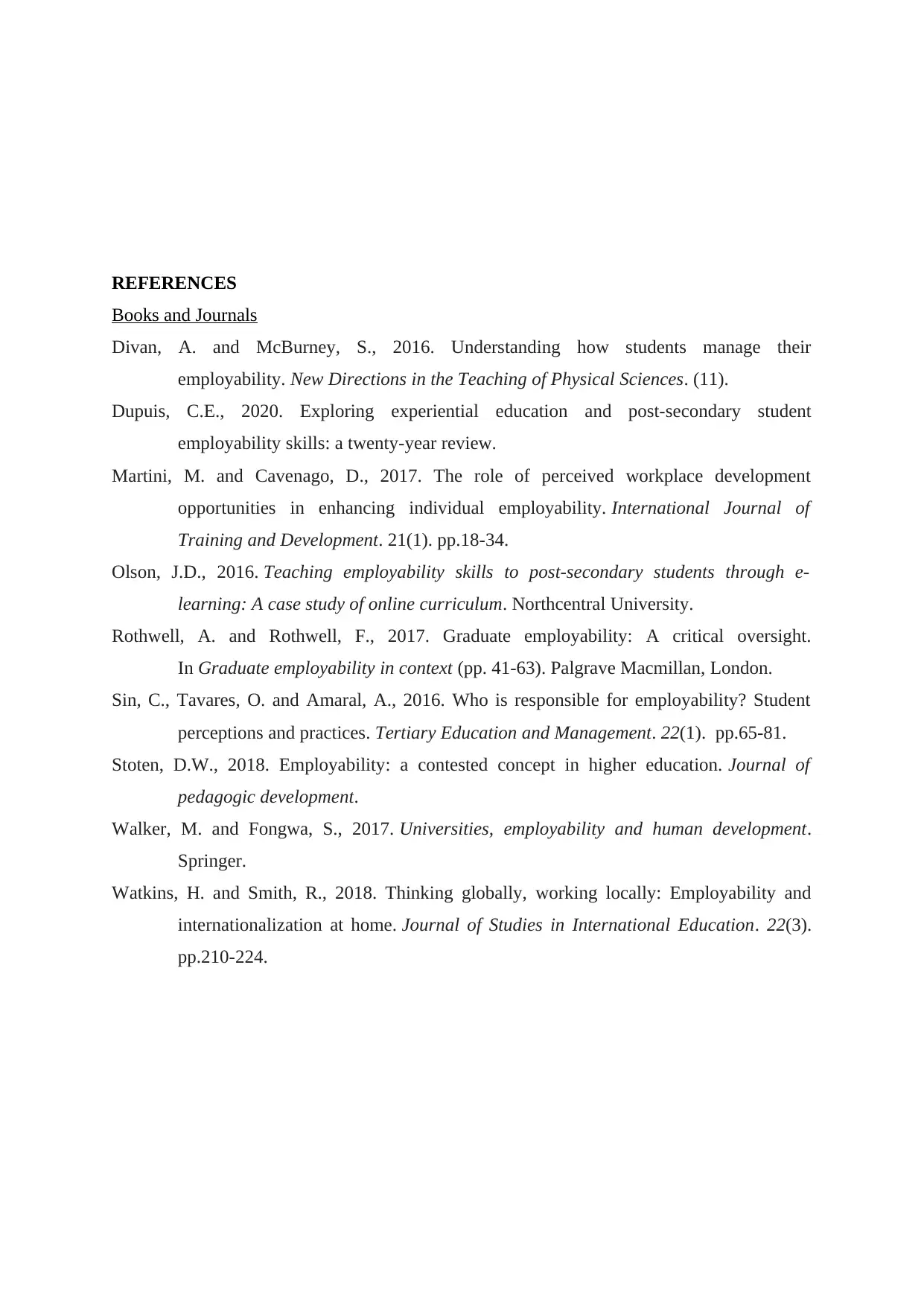
REFERENCES
Books and Journals
Divan, A. and McBurney, S., 2016. Understanding how students manage their
employability. New Directions in the Teaching of Physical Sciences. (11).
Dupuis, C.E., 2020. Exploring experiential education and post-secondary student
employability skills: a twenty-year review.
Martini, M. and Cavenago, D., 2017. The role of perceived workplace development
opportunities in enhancing individual employability. International Journal of
Training and Development. 21(1). pp.18-34.
Olson, J.D., 2016. Teaching employability skills to post-secondary students through e-
learning: A case study of online curriculum. Northcentral University.
Rothwell, A. and Rothwell, F., 2017. Graduate employability: A critical oversight.
In Graduate employability in context (pp. 41-63). Palgrave Macmillan, London.
Sin, C., Tavares, O. and Amaral, A., 2016. Who is responsible for employability? Student
perceptions and practices. Tertiary Education and Management. 22(1). pp.65-81.
Stoten, D.W., 2018. Employability: a contested concept in higher education. Journal of
pedagogic development.
Walker, M. and Fongwa, S., 2017. Universities, employability and human development.
Springer.
Watkins, H. and Smith, R., 2018. Thinking globally, working locally: Employability and
internationalization at home. Journal of Studies in International Education. 22(3).
pp.210-224.
Books and Journals
Divan, A. and McBurney, S., 2016. Understanding how students manage their
employability. New Directions in the Teaching of Physical Sciences. (11).
Dupuis, C.E., 2020. Exploring experiential education and post-secondary student
employability skills: a twenty-year review.
Martini, M. and Cavenago, D., 2017. The role of perceived workplace development
opportunities in enhancing individual employability. International Journal of
Training and Development. 21(1). pp.18-34.
Olson, J.D., 2016. Teaching employability skills to post-secondary students through e-
learning: A case study of online curriculum. Northcentral University.
Rothwell, A. and Rothwell, F., 2017. Graduate employability: A critical oversight.
In Graduate employability in context (pp. 41-63). Palgrave Macmillan, London.
Sin, C., Tavares, O. and Amaral, A., 2016. Who is responsible for employability? Student
perceptions and practices. Tertiary Education and Management. 22(1). pp.65-81.
Stoten, D.W., 2018. Employability: a contested concept in higher education. Journal of
pedagogic development.
Walker, M. and Fongwa, S., 2017. Universities, employability and human development.
Springer.
Watkins, H. and Smith, R., 2018. Thinking globally, working locally: Employability and
internationalization at home. Journal of Studies in International Education. 22(3).
pp.210-224.
⊘ This is a preview!⊘
Do you want full access?
Subscribe today to unlock all pages.

Trusted by 1+ million students worldwide
1 out of 9
Related Documents
Your All-in-One AI-Powered Toolkit for Academic Success.
+13062052269
info@desklib.com
Available 24*7 on WhatsApp / Email
![[object Object]](/_next/static/media/star-bottom.7253800d.svg)
Unlock your academic potential
Copyright © 2020–2026 A2Z Services. All Rights Reserved. Developed and managed by ZUCOL.



